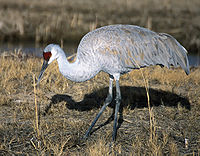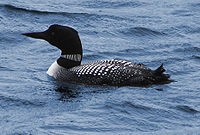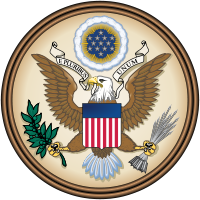- Anishinaabe clan system
-
The Anishinaabe, like most Algonquian-speaking groups in North America, base their system of kinship on patrilineal clans or totems. The Anishinaabe word for clan (doodem) was borrowed into English as totem. The clans, based mainly on animals, were instrumental in traditional occupations, inter-tribal relations, and marriages. Today, the clan remains an important part of Anishinaabe identity.
Contents
Tradition
The Anishinaabe peoples were divided into a number of odoodeman (clans; singular: odoodem) named mainly for animal totems (or doodem, as an Ojibwe person would say this word in English). According to oral tradition, when the Anishinaabe were living along the Atlantic Ocean coast and the great Miigis beings appeared out the sea and taught the Mide way of life to the Waabanakiing peoples, six of the seven great Miigis beings that remained to teach established the odoodeman for the peoples in the east. The five original Anishinaabe totems were Wawaazisii (Bullhead), Baswenaazhi (Echo-maker, i.e., Crane), Aan'aawenh (Pintail Duck), Nooke (Tender, i.e., Bear) and Moozwaanowe ("Little" Moose-tail).
Traditionally, each band had a self-regulating council consisting of leaders of the communities' clans or odoodeman, with the band often identified by the principle doodem. In meeting others, the traditional greeting among the Ojibwe peoples is "What is your doodem?" ("Aaniin odoodemaayan?") in order to establish a social conduct between the two meeting parties as family, friends or enemies. Today, the greeting has been shortened to "Aaniin" (or "Aanii" in Odawa) and used similarly to "Hello."
Etymology
The word odoodem is a dependent noun with the root /-ode/, meaning a "consanguine kin", with the possessive suffix /-m/. When speaking on one's own doodem, the Anishinaabe would say nindoodem(-ag) ("my clan(s)"), gidoodem(-ag) ("your clan(s)") for addressee's and odoodem(-an) ("his/her clan(s)") for other's.
Clan totems
There were at least twenty-one Ojibwe totems in all, recorded by William Whipple Warren. Other recorders, such as John Tanner, list many fewer but with different doodem types. For the Potawatomi, at least 15 different totems were recorded. The Clan types today are quite extensive, but usually only a handful of odoodeman are found in each of the Anishinaabe communities. Like any other Algonquian groups, the Anishinaabe clan system served as a system of government as well as a means of dividing labour. The five groups or phratries are listed below, listing each of the doodem clans or gentes within their group. The known Ojibwa clans are marked with (Oj), Odawa clans with (Od) and Potawatomi clans with (Po).
Moozwaanowe group
The Moozwaanowe group was charged with scouting, hunting and gathering.
- Moozwaanowe ("Little" Moose-tail) (Oj)
- Moozens or Moozoons(ii) (Little Moose)
- Mooz (Moose)
- Adik (Caribou) (Oj)
- The Adik totem is common among the Ojibwa and Oji-Cree north of Lake Superior. A prominent family from this doodem from the Grand Portage area relocated to La Pointe and produced the chiefs Mamongazeda and Waubojeeg. Later members of this branch became leaders at Sault Ste. Marie.
- Waawaashkeshi (Deer)
- Omashkooz (Stag)
- Eshkan (Antler)
- Mishewe (Elk) (Oj, Po)
- Waabizheshi (Marten) (Oj)
 This pictographic 1849 petition shows an Ojibwa chief represented by the Marten doodem.
This pictographic 1849 petition shows an Ojibwa chief represented by the Marten doodem.
- Amik(waa) (Beaver) (Oj, Po)
- Wazhashk (Muskrat) (Oj)
- Gaag (Porcupine)
- Esiban (Raccoon)
- Waabooz(oo) (Rabbit) (Oj, Po)
- Zhaangweshi (Mink)
- Waagoshiinh (Fox) (Po)
Wawaazisii group
The Wawaazisii group was charged with teaching and healing.
- Wawaazisii or Owaazisii (Bullhead) (Oj)
- Googoonh or Namens (Fish)
- Mikinaak (Snapping Turtle) (Oj)
- Mishiikenh (Mud Turtle) (Oj, Po)
- Miskwaadesi (Painted Turtle) (Oj)
- Ginebig (Snake) (Oj)
- Omazaandamo (Black Snake)
- Midewewe or Zhiishiigwe (Rattle Snake)
- Omakakii (Frog) (Po)
- Nigig (Otter)
- Nibiinaabe (Merman)
- Maanameg (Catfish) (Oj)
- Adikameg (Whitefish)
- Namebin(aa) (Sucker) (Oj, Po)
- Name or Maame (Sturgeon) (Oj, Po)
- Ginoozhe (Pike) (Oj)
- Ashaageshiinh (Crab) (Po)
Nooke group
The Nooke group was responsible for defense and healing. Though today the Bear Clan has all merged together into a single clan known as Nooke, at one time the Bear was the largest — so large, in fact, that it was sub-divided into body parts such as the head (Makoshtigwaan or "bear-skull"), the ribs and the feet (Nookezid or "tender-foot"), as well as different types of bears such as the Waabishki-makwa or "White Black bear" and the Mishimakwa or "Grizzly Bear".
Baswenaazhi group
The Baswenaazhi group were traditionally charged with outgoing International communications. Because of this, often members of the Baswenaazhi group are said to be the most vocal.
- Ajijaak(we) (Crane or "Thunder") (Oj, Od, Po)
- Binesi (Thunderbird)
- Gekek (Hawk) (Oj)
- Omigizi(we) (Bald Eagle) (Oj, Od, Po)
- Giniw (Golden Eagle) (Po)
- Bibiigiwizens (Sparrowhawk)(Od)
- Nesawaakwaad ("Forked Tree")
- Makade-gekek(we) (Black Hawk) (Po)
Aan'aawenh group
The Aan'aawenh are charged with Internal/Domestic communications. They were often charged with the community's own council fires and help facilitate dialogue on all internal/domestic issues.
- Aan'aawenh (Pintail) (oj)
- Owewe (Wild Goose or "Swan")
- Bineshiinh (Bird)
- Bine ("Turkey") (Po)
- Nika (Goose)
- Maang (Loon) (Oj, Po)
- (Makade)Zhiishiib ((Black)Duck) (Oj)
- Gayaashk (Gull)
- Jiwiiskwiiskiwe (Snipe) (Oj)
- Omooshka'oozi (Heron) (Oj)
- Zhedeg (Pelicans)
- Ogiishkimanisii (Kingfisher) (Oj)
- Aandeg (Crow) (Po)
- Gaagaagishiinh (Raven)
- Aagask (Grouse)
Metaphors
On occasion, instead of referring to the totem by the actual being's name, a clan is identified instead by a metaphor describing the characteristic of the clan's totem. The metaphors that survive to today include:
- Baswenaazhi "Echo-maker" = Ajijaak(we) "Crane"
- Nooke "Tender" = Makwa "Bear"
- Bimaawidaasi "Carrier" = Amik(waa) "Beaver"
- Giishkizhigwan "Cut-tail" = Maanameg "Catfish"
- Bemaangik "Pass-by Sounder" = Owewe "Wild Goose"
Social order
Some national sub-divisions were simply referred by their major Clan component. A example of this would be Maandawe-doodem ("Fisher-clan") of the Meshkwahkihaki peoples, who live along the south shore of Lake Superior. More inland than the Maandawe-doodem were the Waagosh-doodem ("Fox clan") of the Meshkwahkihaki, who are called the Fox Tribe in English. When the Maandawe were defeated in a major battle between the Ojibwe and the Meshkwahkihaki peoples, the surviving Maandawe were adopted as part of the Ojibwa nation, but instead as the Waabizheshi-doodem ("Marten clan"). Among some Ojibwe people, (though not all) the Waabizheshi clan is also used to denote a form of adoption, i.e., a non-native father and Ojibwe mother. In other instances, for example, odoodem communities such as the Amikwaa were treated as fully interdependent Nations of the Anishinaabeg Confederacy, or given a designation to represent their primary function in the social order, such as with the Manoominikeshiinyag ("Ricing-rails") or the Waawaashkeshi-ininiwag ("Deer[-clan] Men").
Some doodem indicate non-Ojibwe origins. Other than Waabizheshi, these include the Ma'iingan-doodem (Wolf Clan) for Dakota and Migizi-doodem (Eagle Clan) for Americans. There are other odoodem considered rare today among the Ojibwa because the odoodem have migrated into other tribes, such as the Nibiinaabe-doodem (Merman Clan), which shows up as the Water-spirits Clan of the Winnebagoes.
Kinship
Ojibwa understanding of kinship is complex, taking into account of not only the immediate family but also the extended family. It is considered a modified Bifurcate merging kinship system. Consequently, Ojibwa would speak of not only about grandfather (nimishoomis) and grandmother (nookomis), father (noos) and mother (ningashi), and son (ningozis) and daughter (nindaanis), but also would speak of elder brother (nisayenh), younger sibling (nishiimenh), cross-uncle (nizhishenh), parallel-aunt (ninooshenh), male sibling of same gender (niikaanis), female sibling of same gender (niidigikoonh) and sibling of opposite gender (nindawemaa), and cross-cousin of the opposite gender (niinimoshenh), to name only a few.
Siblings generally share the same term with parallel-cousins as with any Bifurcate merging kinship system due to being a member the same doodem, but the modified system allows for younger sibling to share the same kinship term with younger cross-cousins (nishiimenh). In addition the complexity wanes as one goes away from the speaker's immediate generation, with some degree of complexity retained with female relatives (for example, ninooshenh is "my mother's sister" or "my father's sister-in-law"—i.e., my parallel-aunt—but also "my parent's female cross-cousin"). In both with the great-grandparents and older generations and with the great-grandchildren and younger generations, the Ojibwa collectively calls them aanikoobijigan. This sign of kinship/clans speaks of the very nature of the Anishinaabe's entire philosophy/lifestyle, that is of interconnectedness and balance between all living generations and all generations of the past and of the future.
In addition to the Anishinaabeg doodem, clans of other tribes are considered related to the Anishinaabe clans if they have the same designation. Consequently, for example, a union between an Anishinaabe Bear Clan member with a Cherokee Bear Clan member would be considered illegal — even incestuous — by many traditional community groups.
Notable clans
White Crane
The White Crane clan were the traditional hereditary chiefs of the Ojibwe at Sault Ste. Marie and Madeline Island, and were some of the more powerful chiefs encountered by the first French explorers of Lake Superior. Members of the crane clan include:
- Tagwagane- an important chief at Madeline Island in the early 19th century
- Ikwesewe- the wife of Michel Cadotte and the namesake of Madeline Island
Loon
Closely associated with the crane clan, members of the loon clan became important chiefs on Lake Superior's south shore during the fur trade period. Members of the loon clan include:
- Chief Buffalo- a famous chief of Madeline Island
- Walter Bresette- A Red Cliff Ojibwe activist
Bear
Always the most numerous of the Anishinaabeg, members of the bear clan were traditionally the warriors and police (Ogichidaa), as well as the healers. Many members of the clan continue in these roles today. The bear clan provided most of those who participated in the Bad River Train Blockade. In fiction, the police officers in the novels of Louise Erdrich come from the bear clan.
Eagle
Now one of the most common clans, the Eagle totem was once of the smaller clans. However, the number of Eagle totem members grew when new members whose paternal ancestors were Americans were assigned to this totem. Since the first sustained contact by the Anishinaabe with the United States was through government officials, the symbol of the American Eagle was taken for a clan marker. Members of the Eagle clan include:
- William Whipple Warren – a 19th-century Ojibwe historian
- Nahnebahwequa – Mississauga Ojibway missionary and spokeswoman
- Kahkewaquonaby – Mississauga Ojibway Methodist missionary and spokeswoman
External links
- Nindoodemag: The Significance of Algonquian Kinship Networks in the Eastern Great Lakes Region, 1600–1701
- Aboriginal totem signatures, the Great Peace of Montreal, 1701
- DEEDS / NATIONS — Directory of First Nations Individuals in South-Western Ontario 1750 - 1850 by Greg Curnoe, showing some treaty-signatory doodem
- Introduction to Kinship Terms by Dr. J. Rand Valentine.
References
- Benton-Banai, Edward. (1979) The Mishoomis Book.
- Hilger, M. Inez. (1951) Chippewa Child Life and Its Cultural Background.
- Johnson, Basil. (1990) Ojibway Heritage.
- Tanner, John. (1830) A narrative of the captivity and adventures of John Tanner, (U.S. interpreter at the Saut de Ste. Marie,) during thirty years residence among the Indians in the interior of North America, ed. Edwin James.
- Warren, William W. (1851) History of the Ojibway People.
- Mooney and Thomas. (1910) Handbook of American Indians North of Mexico.
Categories:- Anishinaabe culture
- Great Lakes tribal culture
- Odawa
- Ojibwe
- Potawatomi
- Clans by nation
- Native American history of Michigan
- Native American history of Minnesota
- Native American history of Wisconsin
Wikimedia Foundation. 2010.




